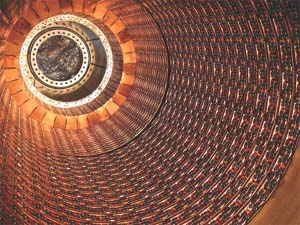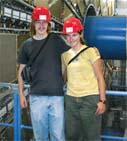 |
 |
| current issue |  |
past issues |  |
send a letter/news |  |
address update |  |
advertise |  |
about us |  |
alumni home |
Campus Currents
|
Code Blue
A UNH senior works on the Hadron Collider |
Easy to print version |

|
Austin Purves '09 had an extra reason to pay attention to the startup of the Large Hadron Collider in Geneva, Switzerland, in September. He was not worried, like some bloggers and others were, that the Earth was going to be swallowed by a black hole created by the collider. Purves was especially interested because during a summer internship at the European Organization of Nuclear Research (CERN), he wrote computer code for one of the collider's detectors, joining the ranks of thousands of scientists worldwide who worked on the collider.
The collider is the world's largest particle accelerator, constructed in a 17-mile tunnel 300 feet underground on the border between Switzerland and France. It took 14 years to build, cost $8 billion, and will try to recreate conditions present just after the Big Bang by accelerating protons and smashing them together. (In late September, after several mishaps, the collider was temporarily shut down for repairs.)
A senior physics major from Silver Spring, Md., Purves got the internship with the help of Per Berglund, a UNH associate professor of physics who worked at CERN in the 1990s. "This new machine will give us new insight into the fundamental laws of physics, and maybe even give hints that string theory is behind it all," says Berglund, who is Purves' research adviser.

|
Purves (pictured at left with his girlfriend, Melanie Schroer '09) worked on software that interprets the results of particle activity in Atlas, a detector that is responsible for locating the Higgs Boson particle, which scientists believe is the missing link to determining how mass and matter originate on a small scale.
"A very small piece of a very large puzzle" is how Purves describes his contribution. A highlight of his summer work was the opportunity to go into the "cave," the underground racetrack, and see the Atlas detector as the assembly was being finished.
Purves, who is interested in fundamental theories of the universe such as string theory, worked 40-hour weeks, spending about a month and a half to complete the data-analysis code. He adds, "I felt like I was challenged."
blog comments powered by Disqus
